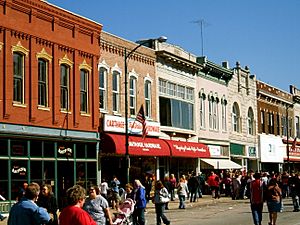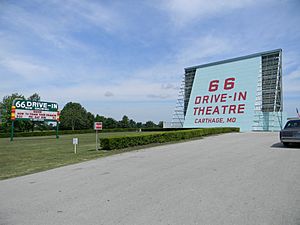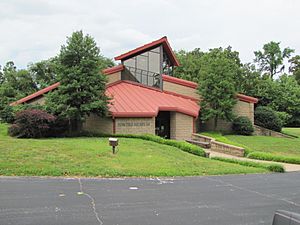Carthage, Missouri facts for kids
Quick facts for kids
Carthage, Missouri
|
|
|---|---|

Stores around the Courthouse square
|
|
| Nickname(s):
America's Maple Leaf City
|
|

Location within Jasper County and Missouri
|
|
| Country | United States |
| State | Missouri |
| County | Jasper |
| Government | |
| • Type | Mayor-council government |
| Area | |
| • Total | 11.95 sq mi (30.96 km2) |
| • Land | 11.91 sq mi (30.84 km2) |
| • Water | 0.05 sq mi (0.12 km2) |
| Elevation | 1,040 ft (320 m) |
| Population
(2020)
|
|
| • Total | 15,522 |
| • Density | 1,303.71/sq mi (503.38/km2) |
| Time zone | UTC-6 (Central (CST)) |
| • Summer (DST) | UTC-5 (CDT) |
| ZIP code |
64836
|
| Area code(s) | 417 |
| FIPS code | 29-11656 |
| GNIS feature ID | 2393760 |
| Website | http://carthagemo.gov/ |
Carthage is a city in Jasper County, Missouri, United States. It is home to about 15,522 people, based on the 2020 census. Carthage is the main city of Jasper County, where the county government is located. It is often called "America's Maple Leaf City" because of its beautiful maple trees.
Contents
History of Carthage

How Carthage Began
Jasper County was created in 1841. Carthage was chosen as its main city. The town was planned out in 1842. It was named after the ancient city of Carthage, a powerful rival of the Roman Republic. By the time of the American Civil War, over 500 people lived here. The town had a courthouse and many businesses.
Carthage During the Civil War
The people in the area had different views on slavery. Many African-Americans in the county were enslaved. A big event, the Battle of Carthage, happened on July 5, 1861. It was a fight between Union soldiers and Confederate troops. The Confederate troops were led by Missouri Governor Claiborne Fox Jackson.
Another battle, called the "Second Battle of Carthage," took place in October 1863. Union soldiers pushed Confederate troops back to Arkansas. The town saw many small fights during the war. In September 1864, pro-Confederate groups burned most of the city, including the courthouse. You can read more about these events in books like Jasper County, Missouri in the Civil War.
Growth After the War
Carthage grew very quickly after the Civil War. The Missouri and Western Railway arrived in 1872. Local people started many new businesses. These included a factory for metal goods, a furniture factory, and mills for wool and grain.
Leggett & Platt, a large company today, started in Carthage in 1883. Nearby lead mines and limestone quarries also brought a lot of money to the town. Carthage became one of the richest towns in the area. People built fancy Victorian-style homes. Many of these homes are now part of a special historic area. The Jasper County Courthouse, built in 1894–95, was made from local Carthage stone. Inside, there is a large painting showing the history of Jasper County.
Carthage Stone and Quarries
Many buildings in Carthage were built using stone from local quarries. This limestone is so strong that it can be polished like marble. It's even called "Carthage marble." This stone was used inside and outside the state capitol building in Jefferson City, Missouri. Today, some old quarries are known as the Carthage Underground. This is a commercial space that uses a small part of the huge underground quarries.
Colleges and Communities
In 1925, Ozark Wesleyan College opened a campus in Carthage. It combined three Methodist colleges. The college closed after a few years. Later, from 1944 to 1971, Our Lady of the Ozarks College used the campus.
Today, the campus is home to a Vietnamese-American Catholic religious group. This group of priests and brothers came from Vietnam in 1975, after the Vietnam War.
Route 66 and Travel
In the 1920s, U.S. Highways 66 and 71 passed through Carthage. For a while, many travelers came through town. Route 66 and U.S. Route 71 met at what is now Central and Garrison Avenue. A motel called Boots Court had a drive-in restaurant there. They even had a radio show called "Breakfast at the Crossroads of America." This name referred to the two major highways meeting in Carthage. Later, Route 66 was changed, and then Interstate 44 replaced it in the 1960s.
Carthage Today: Tourism
In recent years, Carthage has worked to attract tourists. The city highlights its history, like the Battle of Carthage and its Victorian buildings. It also promotes its connection to Historic Route 66. Another popular spot is the Precious Moments hotel and store. Carthage is also close to Branson, a popular music and entertainment city.
Where is Carthage?
Carthage is located south of the Spring River. It is along US Route 71. The city of Joplin is about 12 miles southwest of Carthage. Neosho is about 17 miles to the south.
According to the United States Census Bureau, Carthage covers about 11.69 square miles (30.28 square kilometers). Most of this area is land.
People of Carthage
| Historical population | |||
|---|---|---|---|
| Census | Pop. | %± | |
| 1880 | 4,167 | — | |
| 1890 | 7,981 | 91.5% | |
| 1900 | 9,416 | 18.0% | |
| 1910 | 9,483 | 0.7% | |
| 1920 | 10,068 | 6.2% | |
| 1930 | 9,736 | −3.3% | |
| 1940 | 10,585 | 8.7% | |
| 1950 | 11,188 | 5.7% | |
| 1960 | 11,264 | 0.7% | |
| 1970 | 11,035 | −2.0% | |
| 1980 | 11,104 | 0.6% | |
| 1990 | 10,747 | −3.2% | |
| 2000 | 12,668 | 17.9% | |
| 2010 | 14,502 | 14.5% | |
| 2020 | 15,522 | 7.0% | |
| U.S. Decennial Census | |||
Carthage is part of the Joplin, Missouri Metropolitan Area. In 2020, there were 15,522 people living in Carthage. The population is diverse, with people from many different backgrounds. About 31% of the population identified as Hispanic or Latino.
The average age in Carthage was about 31.9 years old in 2020. About 28.6% of the people were under 18 years old.
What Does Carthage Do? (Economy)
Major Employers in Carthage
Carthage has several important companies. Leggett & Platt is a very large company that makes things for homes. It has its main office in Carthage. H.E. Williams, Inc. makes lights for businesses and factories. Otts Foods, Schreiber Foods, and Goodman Manufacturing all make different food products.
The Carthage Underground was once a quarry. Now it is used for storage, with special climate control. In the early 1900s, Carthage was famous for its "Carthage Marble." This hard, gray limestone came from these mines. It was used in many public buildings, including the Capitol Building in Jefferson City and the Jasper County Courthouse.
Unique Industries
Carthage also has several food factories. In 2003, a special plant opened in Carthage. It was the first of its kind in the United States. This plant uses a process called thermal conversion to turn waste from food processing into useful products.
The Dyno Nobel plant in Carthage is important. It is the only place in North America that makes dynamite.
New Facilities
In 2008, a new city-owned hospital called McCune-Brooks opened. The old hospital building was updated for the Carthage Water and Electric Plant. The new Carthage High School opened in 2009.
Schools and Learning
Carthage is part of the Carthage R-IX School District. The district has five elementary schools, an intermediate center, a 6th Grade Center, Carthage Jr. High School, and Carthage Senior High School.
The town also has a public library, the Carthage Public Library. It is a great place to find books and learn new things.
Fun Things to Do (Arts and Culture)
Historical Events and Sites
Carthage is famous for the Battle of Carthage. This was the first official battle of the American Civil War on July 5, 1861. Local groups sometimes act out the battle. There is also a State Historic Site that remembers this event.
Carthage is located on Historic U.S. Route 66. You can still see the old road and some businesses that served travelers long ago.
Festivals and Celebrations
Since 1966, Carthage has held a festival every October called the Maple Leaf Festival. It lasts for a week. The festival is named after the many maple trees in town. Their leaves turn bright red, orange, and yellow in the fall.
Since 1978, Carthage has also hosted Marian Days. This is a large celebration for Vietnamese American Catholics. Many thousands of people attend this event each year.
Other Attractions
Carthage is home to the Precious Moments Park and Chapel. This is a popular tourist spot. It has paintings and large statues of the famous porcelain figurines.
You can learn more about Carthage's history in books like Jasper County Missouri in the Civil War and Images of America: Carthage, Missouri.
Famous People and Art
The composer James Scott lived in Carthage from 1901 to 1906. He is known as one of the most important composers of classic ragtime music. He started writing music while living in Carthage.
Notable People from Carthage
Many interesting people have connections to Carthage:
- Gideon Winans Allen, (1835–1912), a member of the Wisconsin State Assembly.
- Raymond P. Ayres, (b. 1944), a high-ranking officer in the United States Marine Corps.
- Annie White Baxter (1894–1944), the first woman elected to a public office in Missouri.
- Marcus B. Bell (1893–1981), a U.S. Army brigadier general.
- Emily Newell Blair (1877–1951), a writer, supporter of women's voting rights, and a founder of the League of Women Voters.
- Jann Carl (b. 1960), a television personality from Entertainment Tonight.
- Frances Crowe (1919–2019), a peace activist.
- Tom Flanigan (b. 1953), a former member of the Missouri House of Representatives.
- Carl Hubbell (1903–1988), a Baseball Hall of Fame pitcher for the New York Giants.
- Janet L. Kavandi (b. 1959), an astronaut who flew on three Space Shuttle missions.
- Celia Kaye, (b. 1942), an actress.
- Preston Lacy, (b. 1969), a stunt performer and actor from Jackass.
- David Newell, (1905–1980), an American character actor.
- Marlin Perkins (1905–1986), a zoologist and host of Mutual of Omaha's Wild Kingdom.
- Haven Shepherd (b. 2003), a Paralympic swimmer.
- Belle Starr (Myra MayBelle Shirley) (1848–1889), a famous Wild West outlaw.
- Bertha Teague (1906–1991), a basketball coach and member of the Basketball Hall of Fame.
- Richard M. Webster (1922–1990), a former Speaker of the Missouri House of Representatives.
- William L. Webster, (b. 1953), a former Missouri Attorney General.
- Charles Wright, (b. 1964), a former football player.
- Felix Wright, (b. 1959), an NFL football player.
See also
 In Spanish: Carthage (Misuri) para niños
In Spanish: Carthage (Misuri) para niños


